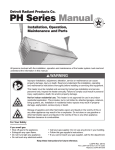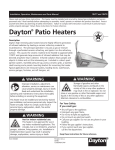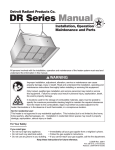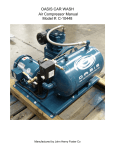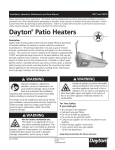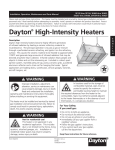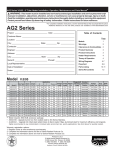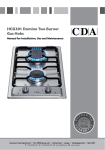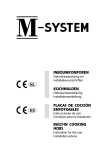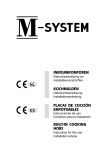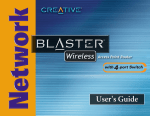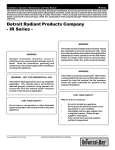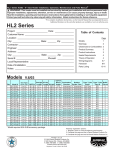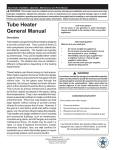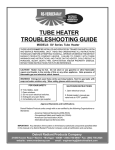Download Detroit Radiant Products SW Series Specifications
Transcript
Patio-Pal® PH Series Patio Heater Installation, Operation, Maintenance and Parts Manual
! WARNING:This heater must be installed and serviced by trained gas installation and service personnel only!
Improper installation, adjustment, alteration, service or maintenance can cause property damage, injury or death.
Read the installation, operating and maintenance instructions thoroughly before installing or servicing this equipment.
Protect yourself and others by observing all safety information. Retain instructions for future reference.
Patio-P
al ®
tio-Pal
For Indoor/Outdoor Commercial Use.
For Outdoor Residential Use.
PH Series
Gas-Fired High Intensity
Infra-Red Patio Heater
! WARNING!
This heater may be used only in outdoor residential
applications or indoor / outdoor commercial (or industrial)
applications. Always observe ventilation requirements as
noted on page 7. This heater is not approved for use in
indoor residential applications (any indoor area attached to
living quarters).
! WARNING!
• Children and adults should be alerted to the hazards of
•
•
! WARNING!
•
NOT FOR INDOOR RESIDENTIAL USE
•
This heater is NOT approved for use in any INDOOR
residential application. This includes (but is not limited
to) attached garages, solariums, living quarters, etc.
Consult the local fire marshal and/or insurance provider
if unsure of your application.
•
high surface temperatures and should stay away to avoid
burns or clothing ignition.
Young children should be carefully supervised when they
are in the area of the heater.
Clothing or other flammable materials should not be hung
from the heater, or placed on or near the heater.
Any guard or other protective device removed for servicing
the heater must be replaced prior to operating the heater .
Installation and repair should be done by a qualified service
person. The heater should be inspected before use and at
least annually by a qualified service person.
More frequent cleaning may be required as necessary. It
is imperative that the control compartment, burners and
circulating air passageways of the heater be kept clean.
! WARNING!
FOR YOUR SAFETY
In locations used for the storage of combustible materials,
signs must be posted to specify the maximum permissible
stacking height to maintain the required clearances from
the heater to the combustibles. Signs must either be
posted adjacent to the heater thermostats or in the
absence of such thermostats in a conspicuous location.
If you smell gas:
1. Shut off gas to the appliance.
2. Extinguish any open flame.
3. If odor continues, immediately call your gas supplier.
FOR YOUR SAFETY
! WARNING!
This is NOT an explosion proof heater. Where there is
the possibility of exposure to flammable vapors, consult
the local fire marshal, the fire insurance carrier and other
authorities for approval of the proposed installation.
Do not store or use gasoline or other flammable vapors and
liquids in the vincinity of this or any other appliances.
Printed in U.S.A.
© 2006 Detroit Radiant Products Co.
21400 Hoover Rd., Warren, MI 48089
T. (586) 756-0950 F. (586) 756-2626
www.reverberray.com
Form # LIOPH-1M-1/06 (DRP)
Replaces Form#LIOPH-1M-12/05
®
Patio-Pal® Installation, Operation, Maintenance and Parts Manual
Patio-Pal® Gas-Fired Infra-Red Patio Heater
Cautions
CAUTION!
The following information should be reviewed
before installing this heater:
•
Check the CSA rating label on the heater to verify
model number. Check and maintain the attached
minimum clearance to combustibles label and the
proper gas to be used. Check all labels on the heater
to verify proper mounting.
•
The installation of this heater must conform with local
building codes or, in the absence of local codes, with
the National Fuel Gas Code, ANSI Z223.1-1999
(NFPA 54-current edition).
•
•
•
The installation of this heater in public garages must
conform with the Standard for Parking Structures,
ANSI / NFPA 88A-current edition: or the Standard for
Repair Garages, ANSI / NFPA 88B-current edition,
and must be at least 8 ft. above the floor while
maintaining all clearances to combustibles.
The installation of this heater in aircraft hangars must
conform to the Standard for Aircraft Hangars, ANSI /
NFPA 409-current edition. The heater must be
installed at least 10 ft. above the upper wing surfaces
and engine enclosures of the highest aircraft which
might be stored in the hangar. In areas adjoining the
aircraft storage area, the heaters must be installed
at least 8 ft. above the floor. The heaters must be
located in areas where they will not be subject to
contact by aircraft, cranes, moveable scaffolding or
other objects.
For installations above 2,000 feet (610 m), the
appliance shall be derated 4 percent for each 1,000
feet (305 m) of elevation above sea level.
2
•
If an external electrical source is utilized, the heater
must be electrically grounded in accordance with
the National Electrical Code, ANSI / NFPA70-current
edition.
•
Under no circumstance is either the gas supply line
or the electrical supply line to the heater to provide
any assistance in the suspension of the heater.
•
The weight of the heater must be entirely suspended
from a permanent part of the building structure having
adequate load characteristics.
•
Neither the gas supply line, electrical supply line nor
sprinkler heads shall be located in or near the path
of the flue products from the heater.
•
This heater cannot be used in a building with an
uninsulated roof or condensation problems could
result.
•
When installed indoors (Commercial/Industrial
Applications Only), natural or mechanical means
shall be provided to supply and exhaust at least
4.0(Nat.) or 4.5(LP) C.F.M. per 1000 BTU/H of the
heater’s rated input.
•
Signs should be posted in storage areas to specify
maximum stacking height allowed in order to
maintain clearance to combustibles. Clearance
safety limit plaques (PLQ), available from Detroit
Radiant Products are recommended for this
purpose.
Patio-Pal® Installation, Operation, Maintenance and Parts Manual
Patio-Pal® Gas-Fired Infra-Red Patio Heater
Clearance to Combustibles
! WARNING!
! WARNING!
Failure to comply with the stated clearance to
combustibles could result in personal injury, death
and/or property damage.
This heater should be installed so that the minimum
clearance to combustibles, as marked on the heater,
will be maintained. If vehicle lifts are present, ensure
that these clearances will be maintained from the
highest raised vehicle.
®
Patio-Pal Clearance To Combustibles
MOUNTING
ANGLE
0°
30°
0°
30°
0°
30°
MODEL NO.
PH 28
28,000 [N,P]
PH 31
31,000 [N,P]
PH 34
34,000 [N,P]
END(S)
SIDE(S)
BELOW
22
22
22
22
22
22
14
N/A
14
N/A
14
N/A
46
46
46
46
46
46
TOP BEHIND FRONT
13
17
13
17
13
17
N/A
8
N/A
8
N/A
8
N/A
46
N/A
46
N/A
46
Figure 1.1 CLEARANCE-TO-COMBUSTIBLES CHART
NOTE: If the heater is mounted beneath a non-combustible surface a 8 in. minimum top clearance
must be maintained from the top of the heater to prevent overheating the controls.
TOP
TOP
BEHIND
SIDE
SIDE
FRONT
BELOW
BELOW
END VIEW
30° MOUNTING ANGLE
END VIEW
0° MOUNTING ANGLE
END
END
SIDE VIEW
3
®
Patio-Pal® Installation, Operation, Maintenance and Parts Manual
Patio-Pal® Gas-Fired Infra-Red Patio Heater
Design
1.1 DESIGN
When positioning heater, keep in mind the clearance to combustibles with materials such as, lights, sprinkler
heads, overhead doors, storage areas with stacked materials, gas and electrical lines, parked vehicles,
cranes, etc. Refer to Figure 1.1 on page 3 for minimum clearance to verify that a safe installation condition
exists. PH Series heaters should never be installed in a recessed ceiling or inside a soffit.
IMPORTANT: In locations used for the storage of combustible materials, signs shall be posted to specify
the maximum permissible stacking height to maintain required clearances from the heater to the
combustibles. Also note that fire sprinkler heads must be located at an appropriate distance from the
heater and that this distance may exceed the published clearance to combustibles. Certain applications
will require the use of high temperature sprinkler heads or the relocation of the heaters. Potentially flammable
substances, such as Propylene Glycol or antifreeze solutions, should not be used in conjunction with our
heaters. For further information consult NFPA 13.
Always observe applicable State and local codes.
NOTE: The effective infrared surface temperature
of a person or object may be diminished with wind
above 5 mph. The use of adequate wind barrier(s)
may be required.
PATIO-PAL® SPOT HEATER LOCATION CHART
MODEL &
INPUT
PH-28
28,000
BTU/H
PH-31
31,000
BTU/H
PH-34
34,000
BTU/H
APPROX.
DIMENSIONS OF
AREA COVERED
APPROX. SQ. FT. RECOMMENDED MOUNTING
COVERED
HEIGHT ("A" DIMENSION)
7' X 7'
49 SQ. FT.
8'-0" to 8'-6"
8' X 8'
64 SQ. FT.
8'-0" to 9'-0"
9' X 9'
81 SQ. FT.
8'-6" to 10'-0"
Figure 1.2
4
Patio-Pal® Installation, Operation, Maintenance and Parts Manual
Patio-Pal® Gas-Fired Infra-Red Patio Heater
Mounting & Dimensional Data
2.1 HEATER MOUNTING
Figures 2.1 and 2.2 illustrate the more commonly
used methods for heater mounting. Figure 2.1 shows
the fastest and most economical method. Some local
codes or application conditions (where heater
movement or vibration is a possibility and a flex
connector is used) stipulate that the heaters must be
rigidly mounted (Figure 2.2).
•
Heater must be level from side to side and the
units must be mounted at a 0° to 30° angle
from horizontal. Gas and electrical lines must
not be located above the path of exhaust.
•
When installing heater on an angle (0-30°) place
the gas & electric inlet side down (Figure 2.2)
Threaded
Rod
This
Side
Up
This
Side
Up
This
Side
Down
This
Side
Down
Figure 2.1 TYPICAL HEATER MOUNTING
Figure 2.2 RIGID HEATER MOUNTING
HEATER DIMENSIONS
8.5”
9”
45.25”
SIDE VIEW
8.5”
9”
45.25”
END VIEW
BOTTOM VIEW
5
®
Patio-Pal® Installation, Operation, Maintenance and Parts Manual
Patio-Pal® Gas-Fired Infra-Red Patio Heater
Gas Supply & Connections
3.1 GAS SUPPLY
MANIFOLD PRESSURE CHART
CAUTION!
CORRECT INLET PRESSURES ARE VITAL FOR
EFFICIENT OPERATION OF HEATER. REFER TO
AGA/CGA RATING PLATE AND, IF NECESSARY,
CONSULT GAS COMPANY.
Required Manifold
Pressure (WCP)
Minimum
Inlet Pressure
(WCP)
Maximum
Inlet Pressure
(WCP)
Natural Gas
5.0 in.
6.0 in.
14.0 in.
Liquified Petroleum
Gas
10.0 in.
11.0 in.
14.0 in.
Figure 3.1
If all or a portion of the gas supply line consists of used
pipe, it must be cleaned and then inspected to determine
its equivalency to new pipe. Test all main supply lines
according to local codes. (Isolate heater gas valve and
supplied gas cock during test.)
Allowance for Expansion
•
Excessive torque on the manifold may misalign the
orifice(s). Always use two wrenches when tightening
mating pipe connections.
Allowances must be made for the system to expand.
The use of a stainless steel, flexible gas connector
is recommended. If, however, local codes require
rigid piping to the heater, a swing joint can be used.
Gas Line Connection
•
WARNING!
Never use a match or any other flame to test for
gas leaks. Use a soap and water solution to check
for leaks.
•
•
If any portion of the gas supply line is located in an area
that could cause an abnormal amount of condensate to
occur in the pipe, a sediment trap should be installed.
•
NOTE: For high pressure gas above 14 in. W.C.P.
(Water Column), a high pressure regulator and gas cock
must be used. If compressed air is used to detect leaks
in the gas supply line, disconnect and cap shutoff cock
to avoid damage to regulator and gas valve.
•
•
A sediment trap in the gas line will decrease the possibility
of any loose scale or dirt in the supply line entering the
heater’s control system and causing a malfunction.
Provide a 1/8 in. (3.2mm) NPT, plugged tapping
accessible for test gauge connection immediately up
stream of gas connection to heater. Consult gas
company for the proper pipe sizing. The gas supply line
must be of sufficient size to provide the required capacity
and inlet pressure to the heater.
•
•
•
NOTE: Manifold pressure should be checked at the tap
on the gas valve. Readings will be above atmospheric
pressure (during operation). Use only a pipe joint
compound that is resistant to liquified petroleum gasses.
The following guidelines must be observed to ensure
proper system performance and safety:
The gas outlet shall be in the same room as the
appliance and the connector must not be concealed
within or run through any wall, floor or partition.
The connector shall be of adequate length.
The final assembly shall be tested for leaks.
CAUTION: Matches, candles, open flame or other
sources of ignition shall not be used for this purpose.
Leak test solutions may cause corrosion-water rinse
after test.
Contact with foreign objects or substances should
be avoided.
The connector should not be kinked, twisted or
torqued.
Connectors are for use only on piping systems
having fuel gas pressures not in excess of ½ pound
per square inch or 14.0 in. W.C.P.
Bending, flexing and vibration to the gas connections
should be avoided.
The appliance and it’s individual shutoff valve must
be disconnected from the gas supply piping system
during any pressure testing of that system at test
pressures in excess of 1/2 psig (3.5 kPa).
The appliance must be isolated from the gas supply
piping system by closing its individual manual shutoff
valve during any pressure testing of the gas supply
piping system at test pressures equal to or less than
1/2 psig (3.5 kPa).
CAUTION!
CONNECTOR NUTS MUST NOT BE CONNECTED DIRECTLY
TO PIPE THREADS. THIS CONNECTOR MUST BE
INSTALLED WITH ADAPTORS PROVIDED. DO NOT REUSE.
6
Patio-Pal® Installation, Operation, Maintenance and Parts Manual
Patio-Pal® Gas-Fired Infra-Red Patio Heater
Ventilation & Field Wiring
4.1 Ventilation
It is required that the upper levels of the space to be
heated are properly ventilated to supply combustion
air to the heaters and to sufficiently dilute the products
of combustion. This also prevents excessive humidity
buildup. With heaters mounted overhead and a
properly designed ventilation system, products of
combustion and excessive drafts will never be present
at occupancy levels.
For proper ventilation, a positive air displacement
of 4.0 CFM per 1000 BTU/H of natural gas consumed
must be provided. If propane is used, a positive air
displacement of 4.5 CFM per 1000 BTU/H of
propane gas consumed must be provided. Many large
industrial buildings have sufficient air movement to
satisfy these dilution requirements. This air
displacement may be accomplished by either gravity
or mechanical means. Provisions must be made to
provide sufficient fresh air intake area and exhaust air
outlet area.
PH
Ser
Mechanical exhausters are preferred and
typically mounted at high points of the building
on areas of the roof where stagnant air can
accumulate under the deck. For a flat roof,
considerations of prevailing winds, high and low
pressure areas, and distribution of air movement
must be taken into consideration when locating
exhausters.
Best air distribution is accomplished by using a
number of small exhausters versus one large
exhauster. Provide a minimum of one square
inch of net free inlet area per 1000 BTU/H for
combustion air supply. Inlet opening in the
building should be well distributed high in the
sidewalls and should direct incoming air upward
to dilute products of combustion while preventing
drafts at lower levels. Inlets are typically 1 to 3
sq. ft.
Local codes may require that mechanical exhaust
systems be interlocked with heaters to enable
both to function simultaneously.
PH
ies
Thermostat
Ser
PH
ies
Ser
ies
Thermostat
Exhaust Fan
L1
L1
L2
L2
Figure 4.1 TYPICAL FIELD WIRING
7
®
Patio-Pal® Installation, Operation, Maintenance and Parts Manual
Patio-Pal® Gas-Fired Infra-Red Patio Heater
Operation & Wiring Diagrams
5.1 Operation
·
Starting Circuit (see internal wiring diagrams)
·
Running Circuit
After ignition, the flame rod monitors the flame. As long
as a flame is present, the valve is held open. If the
flame is lost, the control acts to close the valve within
one second, and a new trial sequence identical to that
at start-up is initiated. If proof of flame is not established
within the 15 second trial for ignition, the unit will retry
two additional times before entering lockout mode. If
lockout occurs, the control can be reset by briefly
interrupting the power source.
When voltage is applied to L1 and L2, a circuit is
completed from L1 via the blower motor to L2. The
blower fan is mounted in the control box and rated to
supply sufficient air for combustion.
Air pressure generated by the blower will cause the
normally open pressure switch to close. Another circuit
is completed from L1 to the spark ignition module and
back to L2. After a seven (7) second pre-purge, the
spark electrode and gas valve are energized
simultaneously. The trial for ignition is fifteen seconds.
Internal Wiring Diagrams
L2
L1
L1
120V
L2
120V
G
PICKER
RELAY
Fan
NO NC
COM
THERMAL
SWITCH
PRESSURE SWITCH
Fan
24V
G
O
T STAT
N EUTRAL
V ALVE
G ROUND
HV
S ENSE
N EUTRAL
T STAT
N EUTRAL
V ALVE
G ROUND
S ENSE
N EUTRAL
HV
PRESSURE
SWITCH
DSI MODULE (120V)
O
DSI MODULE (120V)
T-STAT
TERMINAL
G
G
W
W
BK
BK
W
W
BK
W
GAS VALVE
W
BK
GAS VALVE
ELECTRODE
ASSEMBLY
ELECTRODE
ASSEMBLY
ELECTRICAL DIAGRAM
ELECTRICAL DIAGRAM
Figure 5.1 PH SERIES 120V
Figure 5.2 PH SERIES 120V WITH 24V CONTROL
8
Patio-Pal® Installation, Operation, Maintenance and Parts Manual
Patio-Pal® Gas-Fired Infra-Red Patio Heater
Maintenance & Troubleshooting
6.1 MAINTENANCE
!
WARNING!
Disconnect all power sources related to the
installation before servicing any component.
Use protective glasses when cleaning the heater.
If the control assembly is not completely
disconnected from the manifold, the high air
pressure will cause the controls to become
defective.
It is recommended that the following become a
standard yearly procedure to obtain maximum
operating efficiency and trouble free operation.
During long periods of non-usage, remove or cover heater
with a polyethylene bag and shut off gas supply. If further
service to the heater is desired, contact your
representative or the factory.
Main Burner
1. Use an air hose to blow any accumulated dust and/
or dirt off the heater. Air hose pressure should
not exceed 30 psig.
2. Pass the air hose over the entire exposed area of
the ceramic. A distance of 2’ to 4’ from the unit is
recommended.
3. Place the air hose outlet into each venturi tube and
allow the air to flow for approximately one minute.
7.1 TROUBLESHOOTING
SYMPTOM
Burning of gas-air mixture inside
plenum (flashback).
Delayed ignition.
Low ceramic surface temperature,
excessive rollout
or soot on
rods.
Control system overheating.
Gas odor.
Heater cycles repeatedly.
No spark; no ignition.
Heater lights, and "locks out" after
approximately 10 seconds.
Spark is present. No main gas
operation. Unit "locks out".
Heater will not shut off.
POSSIBLE CAUSE
1. Heater mounted at incorrect angle.
2. Excessive drafts.
3. Gas leaking at orifice, spud, pilot tube.
4. Separation of ceramic grids.
5. Ceramic grids cracked.
1. Electrode out of specification.
2. Low gas pressure.
3. Partially blocked orifice.
4. Improper orifice size.
5. Incorrect gas.
1. Dirty or plugged burner ceramics.
2. Partially blocked orifice.
3. Low inlet gas pressure.
4. High or Low manifold gas pressure.
5. Foreign matter in venturi tube.
6. Excessive dark spots on burner.
7. Gas supply piping too small.
8. Incorrect gas.
1. Heater not mounted correctly.
2. Heater mounted too close to ceiling.
1. Loose pipe connection.
1. Heater located in drafty area.
2. Low gas pressure.
3. Thermostat located in drafty area.
5. Defective flame electrode or circuit board.
1. Lack of 120V or 24V incoming voltage.
2. Open high voltage wire.
3. Improper electrode gap.
4. Loose or open wire connection.
5. Pressure switch not satisfied.
6. Poor or no equipment ground.
7. Unit in "safety lockout" mode.
8. Defective "Gaslighter" control.
1. Poor or no equipment ground.
2. Polarity is reversed.
3. Low gas pressure.
4. Electrode not sensing.
5. Heater mounted at incorrect angle.
6. Defective "Gaslighter" control.
1. Gas valve in "OFF" position.
2. Defective gas valve.
3. Defective "Gaslighter" control.
1. Defective thermostat or wiring.
2. Gas valve stuck open.
3. High gas pressure.
9
CORRECTIVE ACTION
1. Mounting angle 0º-30º.
2. Relocate or shield from draft.
3. Check with leak detector solution.
4. Replace burner.
5. Replace burner.
1. See Ignition System insert.
2. See Section 3.1, Gas Supply.
3. Clean or replace.
4. Consult dealer.
5. See unit nameplate.
1. See perodic maintenance instructions.
2. Remove and clean.
3. See Section 3.1, Gas Supply.
4. Adjust main valve regulator as specified.
5. See periodic maintenance instructions.
6. See periodic maintenance instructions.
7. Increase inlet pressure or replace undersized piping.
8. See unit nameplate.
1. Mounting angle 0º-30º. Level heater left to right.
2. Observe clearance to combustibles
1. Check all connections. Tighten as necessary.
1. Relocate or shield from draft.
2. See Section 3.1, Gas Supply.
3. Relocate thermostat.
5. Replace.
1. Check power supply.
2. Isolate and ohm for resistance, replace if 0.
3. See Ignition System specifications.
4. Check all wires, tighten or replace.
5. Verify fan operation. Remove obstructions.
6. Check all connections, provide positive earth ground.
7. Interrupt power source, repeat trial for ignition.
8. Replace.
1. Check all connections, provide positive earth ground.
2. 120V to black, neutral to white.
3. See Section 3.1, Gas Supply.
4. Relocate or replace if defective.
5. Mounting angle 0º-30º.
6. Replace.
1. Turn to "ON" position.
2. Isolate and check for resistance. Replace if 0.
3. Replace.
1. Replace or repair.
2. Replace.
3. See Section 3.1, Gas Supply.
®
Patio-Pal® Installation, Operation, Maintenance and Parts Manual
Patio-Pal® Gas-Fired Infra-Red Patio Heater
Parts Breakdown
10
11
EGG CRATE HOLD DOWN
FAN
FAN MOUNTING PANEL
AIR DISTRIBUTION CHANNEL
PICKER RELAY
120 VOLT CORD
24 VOLT CORD
STRAIN RELIEF
PH-113
PH-115
PH-116
PH-117
PH-125
PH-133
PH-134
PH-137
GAS ORIFICE
LOCK WASHER
NUT
PH-145
PH-146
PH-143
PH-144
CLOSE PIPE NIPPLE
3/8" REDUCER FITTING
PH-142
GAS VALVE - NATURAL GAS
EGG CRATE FRAME
PH-112
GAS VALVE - PROPANE
EGG CRATE
PH-111
PH-141
RAIN GUARD
PH-110
PH-140
HANGING BRACKETS
END PANEL
PH-106
BURNER END MOUNTING PANEL
CONTROL BOX COVER W/HINGE
PH-105
PH-108
CONTROL END PANEL W/ LOUVERS
PH-104
PH-107
LEFT FRAME SIDE PANEL (GAS & ELECTRIC)
RIGHT FRAME SIDE PANEL
PH-103
DESCRIPTION
PH-102
TOP PANEL
PART#
PH-101
PH-199
PH-198
PH-197
PH-196
PH-174
PH-173
PH-172
PH-171
PH-170
PH-169
PH-168
PH-163
PH-162
PH-161
PH-160
PH-157
PH-156
PH-155
PH-153
PH-152
PH-151
PH-150
PH-149
PH-148
PH-147
PART#
DESCRIPTION
"TENSION" CLIPS
3/8" NUTS
3/8" BOLTS
3/8" SCREWS
BURNER & ELECTRODE MOUNTING PANEL
CONTROLS FLASHSHIELD
VALVE MOUNTING PANEL
VALVE MOUNTING BRACKET
INTERNAL BURNER ASSEMBLY W/ HOLDDOWNS & FOOTINGS
"THREADED" BARB FITTING
BRASS FITTING
LONG HOSE
SHORT HOSE
PRESSURE SWITCH (TP-264B)
PRESSURE SWITCH MOUNTING BRACKET
THERMAL FUSE
ORANGE CONNECTOR (WIRE NUT)
ORANGE WIRE W/BOOT
CONTROLS MOUNTING PANEL
100-900 HARNESS (DRWH-120)
CIRCUIT BOARD (MARK 10DX-117)
IGNITOR ELECTRODE
RUBBER INLET GROMMET
3/8" GAS COCK
3/8" INCOMING PIPE NIPPLE
Patio-Pal® PARTS LIST
Patio-Pal® Gas-Fired Infra-Red Patio Heater
Patio-Pal® Installation, Operation, Maintenance and Parts Manual
Parts List
®
Patio-Pal® Installation, Operation, Maintenance and Parts Manual
Patio-Pal® Gas-Fired Infra-Red Patio Heater
Limited Warranty
Limited Warranty
One-Year Limited Warranty. Patio Heaters covered in this manual, are warranted by Detroit Radiant Products Company to
the original user against defects in workmanship or materials under normal use for one year after date of purchase. Any part
which is determined to be defective in material or workmanship and returned to an authorized service location, as Detroit Radiant
Products Company designates, shipping costs prepaid, will be, as the exclusive remedy, repaired or replaced at Detroit Radiant
Products Company’s option. For limited warranty claim procedures, see PROMPT DISPOSITION below. This limited warranty
gives purchasers specific legal rights which vary from jurisdiction to jurisdiction.
Additional Limited Warranty. In addition to the above mentioned one-year warranty, Detroit Radiant Products Company
warrants the original purchaser an additional two-year extension on the ceramic burner. This extension excludes electrical/
purchased components.
Limitation of Liability. To the extent allowable under applicable law, Detroit Radiant Products Company’s liability for
consequential and incidental damages is expressly disclaimed. Detroit Radiant Products Company’s liability in all events is
limited to and shall not exceed the purchase price paid.
Warranty Disclaimer. Detroit Radiant Products Company has made a diligent effort to provide product information and
illustrate the products in this literature accurately; however, such information and illustrations are for the sole purpose of
identification, and do not express or imply a warranty that the products are merchantable, or fit for a particular purpose, or that
the products will necessarily conform to the illustrations or descriptions. Except as provided below, no warranty or affirmation
of fact, expressed or implied, other than as stated in the “LIMITED WARRANTY” above is made or authorized by Detroit Radiant
Products Company.
Product Suitability. Many jurisdictions have codes and regulations governing sales, construction, installation, and/or use of
products for certain purposes, which may vary from those in neighboring areas. While Detroit Radiant Products Company
attempts to assure that its products comply with as many codes, it cannot guarantee compliance, and cannot be responsible
for how the product is installed or used. Before purchase and use of a product, review the product applications, and all
applicable national and local codes and regulations, and be sure that the product, installation, and use will comply with them.
Certain aspects of disclaimers are not applicable to consumer products: e.g., (a) some jurisdictions do not allow the exclusion
or limitation of incidental or consequential damages, so the above limitation or exclusion may not apply to you: (b) also, some
jurisdictions do not allow a limitation on how long an implied warranty lasts, consequently the above limitation may not apply to
you: and (c) by law, during the period of this limited warranty, any implied warranties of implied merchantability or fitness for a
particular purpose applicable to consumer products purchased by consumers, may not be excluded or otherwise disclaimed.
Prompt Disposition. Detroit Radiant Products Company will make a good faith effort for prompt correction or other adjustment
with respect to any product which proves to be defective within limited warranty. For any product believed to be defective within
limited warranty, first write or call dealer from whom the product was purchased. Dealer will give additional directions. If unable
to resolve satisfactorily, write to Detroit Radiant Products Company at address below, giving dealer’s name, address, date and
number of dealer’s invoice, and describe the nature of the defect. Title and risk of loss pass to buyer on delivery to common
carrier. If product was damaged in transit to you, file claim with carrier.
Registration. Register on-line at www.reverberray.com/warranty.
Detroit Radiant Products Company
21400 Hoover Road Warren, MI 48089 U.S.A.
Voice: (586) 756-0950
Fax: (586) 756-2626
Website: www.reverberray.com
12












